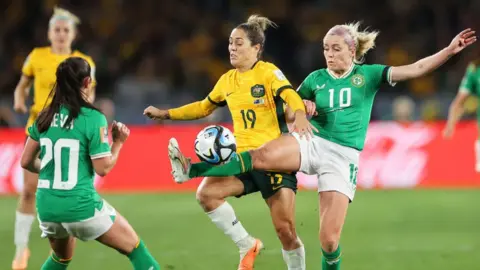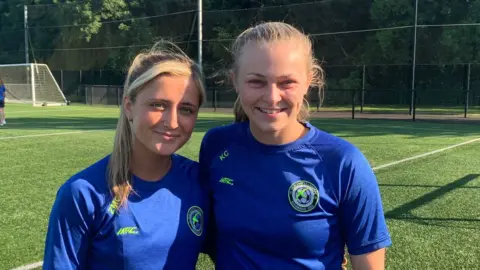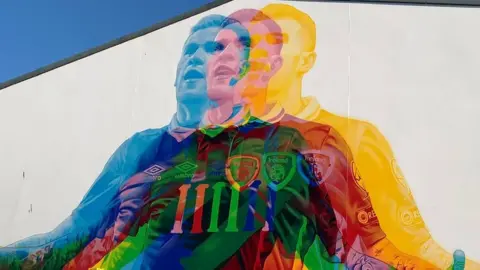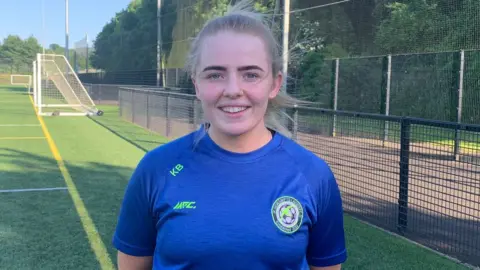Women's World Cup 2023: Northern Ireland's divided loyalties
 Getty Images
Getty ImagesWhen the Republic of Ireland took to the pitch at the Women's World Cup, it was a historic first appearance at the tournament.
Sadly for them, it didn't last all that long and they were knocked out at the group stages after losing to co-hosts Australia on Thursday and Olympic champions Canada earlier.
While they're in action, fans are willing them on with chants of "come on you girls in green".
But those cheers come from both sides of the border with Northern Ireland, even though only one team is in the 2023 tournament.
For a sport where local derbies, international rivalries and hometown grudges play out in stadiums every week, the twin support might seem surprising.
But not here.
In fact, in Northern Ireland, there's a small club where players who've gone on to represent both teams have shared the pitch as team-mates.
If you find Melvin Sports Complex on a map, you can follow the river that runs alongside Sion Swifts' home ground right to the Irish border.
Just a mile from the centre circle you cross a bridge from Strabane, County Tyrone, and arrive in Lifford, County Donegal, in the Republic of Ireland.
Some of the current squad played with Ireland midfielder Ciara Grant when she was at the club - which recruits from both jurisdictions - in 2019.

Vice-captain Kelly Crompton has played for Sion Swifts since primary school.
"I thought Ireland would make it to a World Cup eventually, now the hard work has finally paid off," she tells BBC Newsbeat.
"They have a real opportunity to show what they've got to the world now."
Zoe McGlynn says growing up with brothers was her route into football.
"We always had Ireland games on at the house. I was playing football with my brothers and watching the matches from when I was five or six," she says.
"I'm so proud of this team. To have a past player like Ciara out there is incredible."
A history of two halves
Since the peace deal in 1998, people living in Northern Ireland can choose to be Irish, British or both.
That choice for football fans and players came much earlier.
Paul Rouse is a professor of history at University College Dublin and he says the split in football goes back to the partition of Ireland in the 1920s.
He explains that teams in most sports were able to recruit players from both sides of the border.
But in football, two rival governing bodies sprung up.

Paul says there was a period until the 1950s when both teams called themselves Ireland and recruited players from either side of the border.
But world governing body FIFA put a stop to this, insisting on "a clear separation", he says.
"One team was called Northern Ireland and the other the Republic of Ireland from that point on."
Players in Northern Ireland can choose to represent either team, and that choice depends on their cultural identity, according to Paul.
"They pick a team that represents their national identity, often the community where they grow up."

Sion Swift Kerry Brown has represented the Republic of Ireland at younger age groups.
"I've always supported Ireland. It's hard to describe what it's like to play for your country, hearing that national anthem is something special," she says.
Kerry thinks seeing the team play in the World Cup will inspire young girls both north and south of the Irish border to play football.
"There are so many younger girls with those players' names on the back of their shirts now."

More from the Women's World Cup


